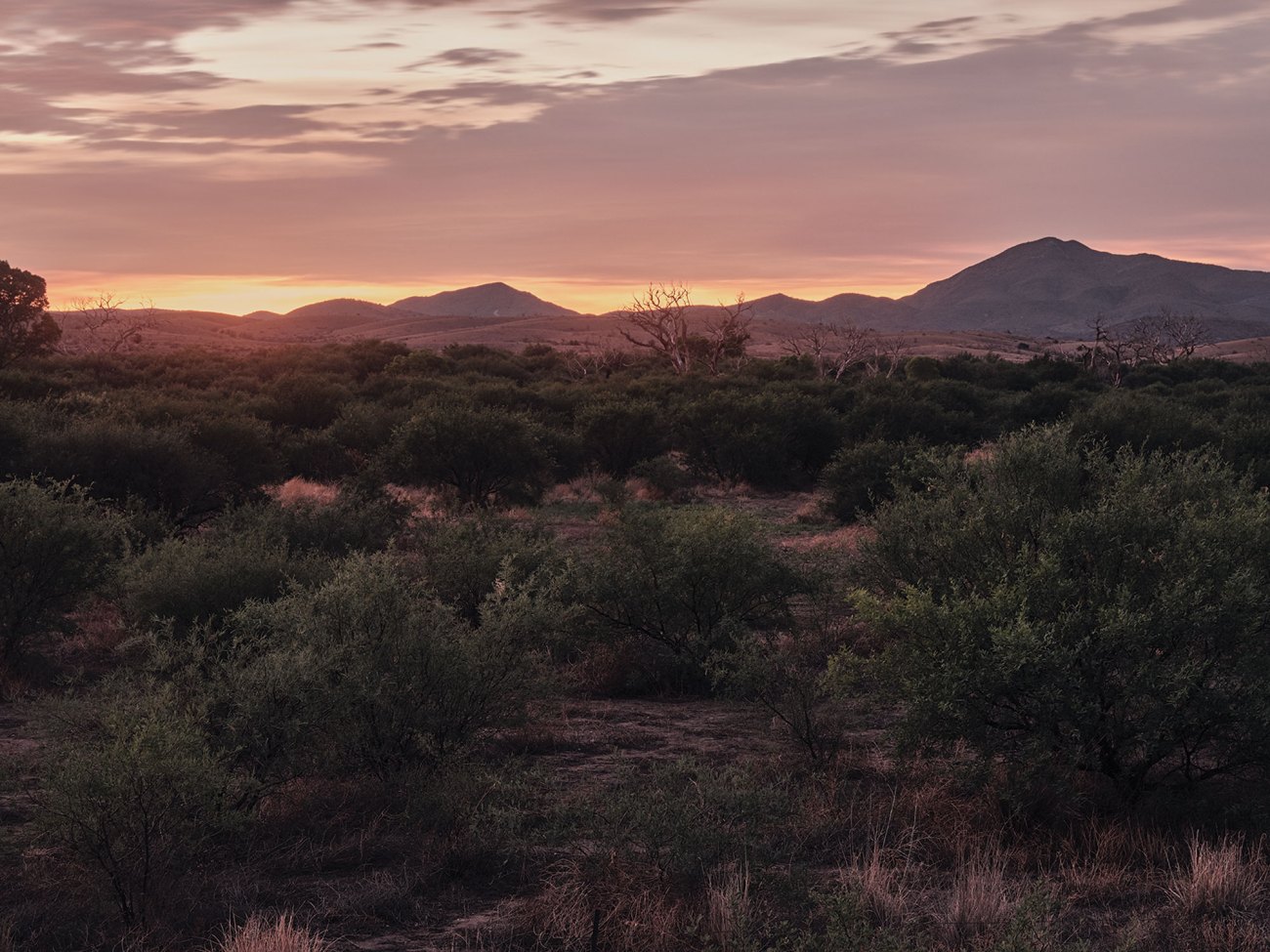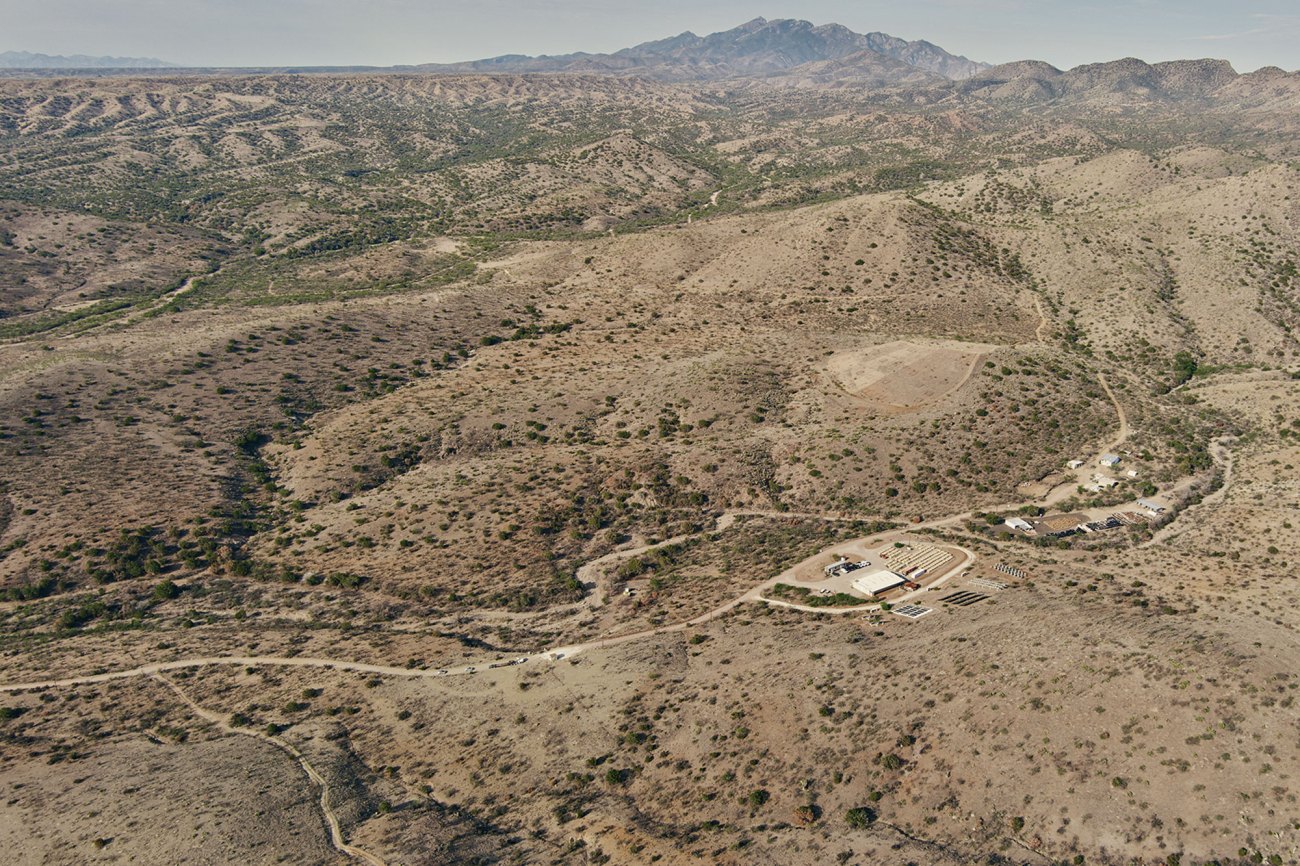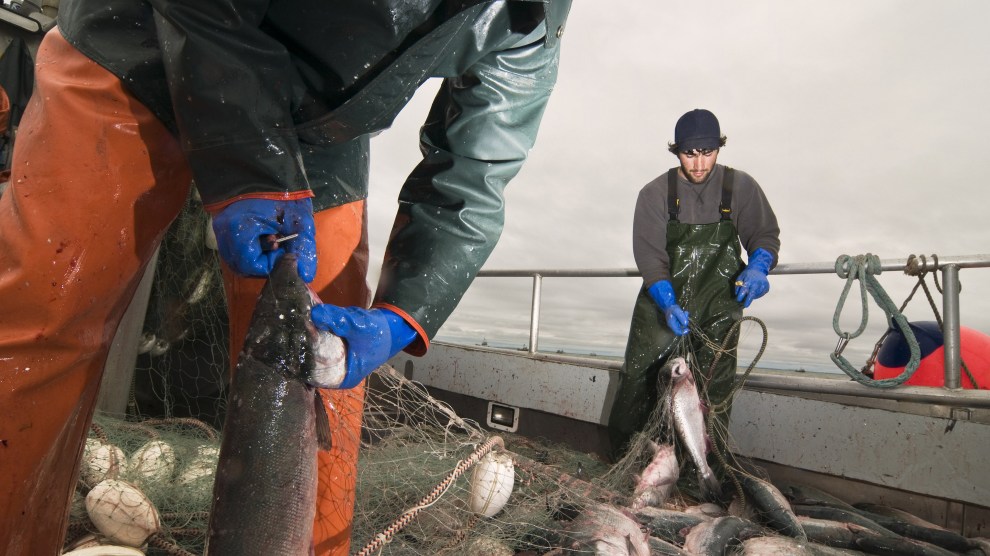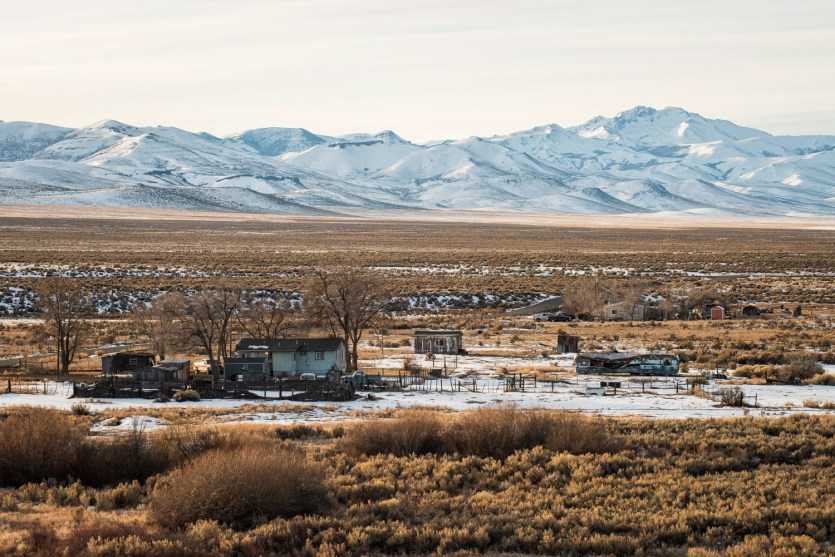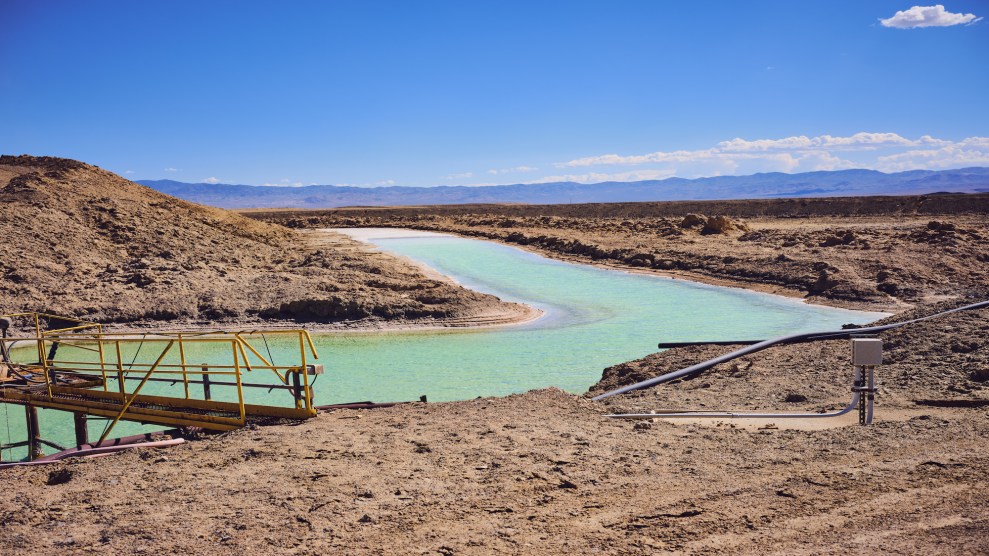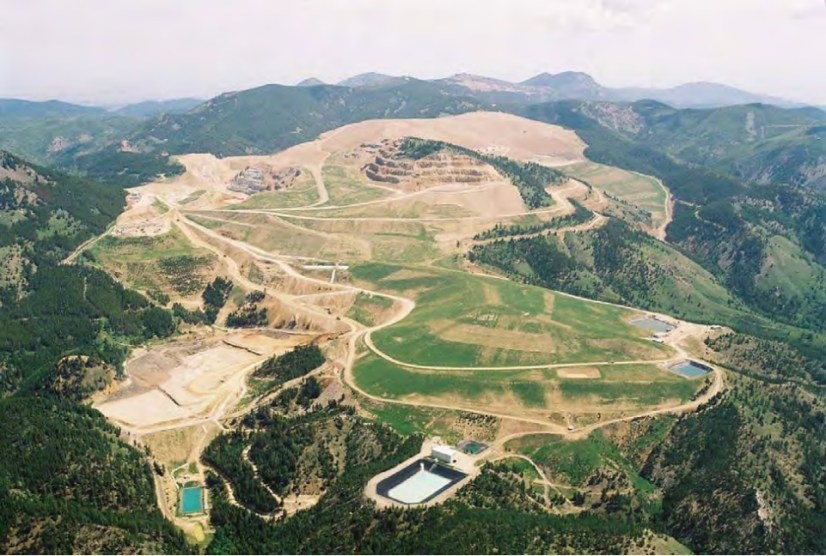Early one May morning, I escaped Tucson’s unrelenting grid and drove south through Pima County on Arizona’s state Route 83, into the heart of the Madrean Sky Islands, an almost mythical landscape of shadowy, isolated peaks where several biological zones overlap. The blue-gray Whetstone Mountains marked the distant eastern horizon, the Patagonias loomed to the south, and to the immediate west rose the camelback ridgeline of the Santa Ritas. There, oaks and junipers stippled upper elevations, and rolling swells of grass blanketed low slopes. A haven for wildlife and a balm for those seeking respite in nature, this region contains some of the rarest intact ecosystems and the highest-quality streams among the deserts of the Southwest, providing habitat for ocelots, jaguars, and a dozen other endangered species.
I parked just off a rutted dirt road in the Coronado National Forest and walked several miles through sagebrush, mesquite, and brightly colored wildflowers. I was looking for old mining claim stakes and signs of big cats but contented myself with vultures, mule deer, and rabbits. Long before Spanish and American colonization, Native peoples prospected these mountains, leaving small scars on the hillsides. More than a century of grazing has helped woody shrubs displace grasslands, a process that climate change is exacerbating.
But worse may soon come. In 2017, the Forest Service, mandated to promote both production and recreation on public lands, approved a plan for the Rosemont Copper Company, a subsidiary of Canada-based Hudbay Minerals, to gouge some 660 million tons of rich ore out of this ground. To get at the precious metal, the company plans to excavate a conical pit roughly a mile wide and some 2,900 feet deep—sufficient to bury the Burj Khalifa, the world’s tallest structure. As it burrows through the water table, Rosemont will spit out 1.2 billion tons of waste rock and another 700 million tons of tailings, the finely ground material left after most metals and minerals have been extracted from ore, to be dumped and piled in massive heaps over several thousands of acres of adjacent Forest Service land.
The forest, the grasslands, and the washes that drain them will be no more. Mountain views will be obliterated, along with 18 miles of streams. When mining operations conclude approximately 20 to 25 years after they start, a deep lake will form inside that ore pit. Not only will this perpetually evaporating sink concentrate heavy metals and likely become toxic, it will also permanently reverse groundwater flows away from seeps, springs, and riparian areas for miles around.
I reached a spot within the mine’s planned footprint and sat. The wind shushed, and butterflies flitted. In 100 years, much of what was before me would be underwater, and the golden corrugation of land to the east would be buried under mounds of debris. Rosemont calls the shapes it would create “landforms”—a word that usually describes natural features. The company’s computer renderings of the site, with their sterile geometries of cone (the pit) and polygon (the plateaus of waste), evoked the land art of Robert Smithson. Their monochromatic regularity belied no sense that the ground they would cover is exuberantly alive.
The Rosemont mine would not be some weird outlier of public lands despoliation. Thousands of hardrock mines throughout the West have left behind similar ravages, all of which can be attributed to the General Mining Act of 1872, which has long been interpreted to give the mining industry the right to occupy public lands upon which valuable minerals have been found, no matter a mine’s impact on environmental or cultural resources. Written when miners with burros and pickaxes filled carts with high-quality deposits and rode away from relatively tiny piles of leavings, the law now seems an absurdly inappropriate legal framework for today’s mega-operators, who gouge low-grade ore from giant pits using electric shovels sporting 60-cubic-yard buckets while generating billions of tons of waste.
I continued my wanderings, following streambeds that were dry on that day but aren’t always: Each year, 20 inches of precipitation fall on and filter through the Santa Rita Mountains, twice the amount Tucson receives. Walking through the shade of Arizona white oaks and desert willows, I understood that water wasn’t far from the surface—these are thirsty trees—and that mining operations would eventually kill them.
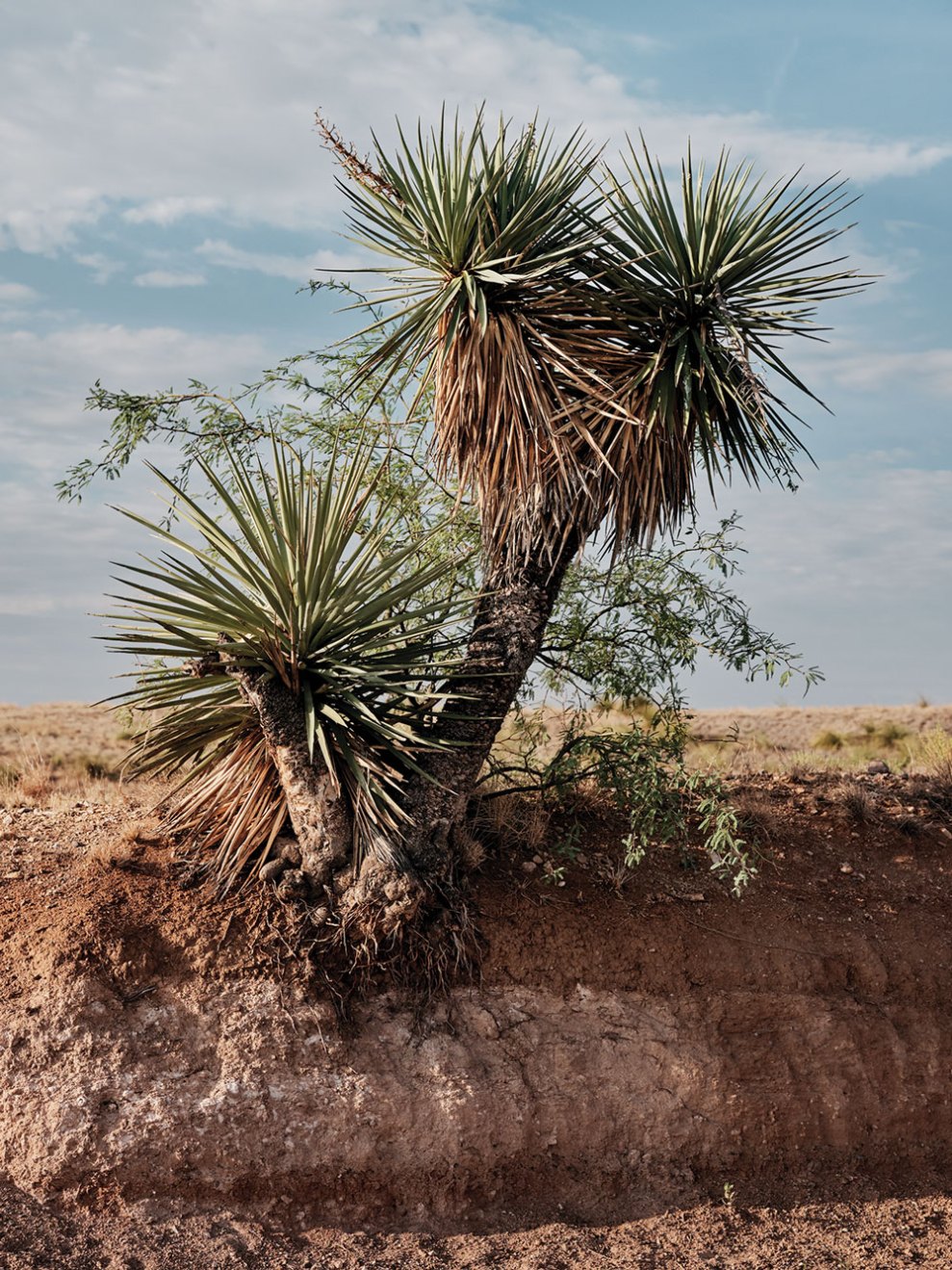
Las Cienegas National Conservation Area.
Benjamin Rasmussen
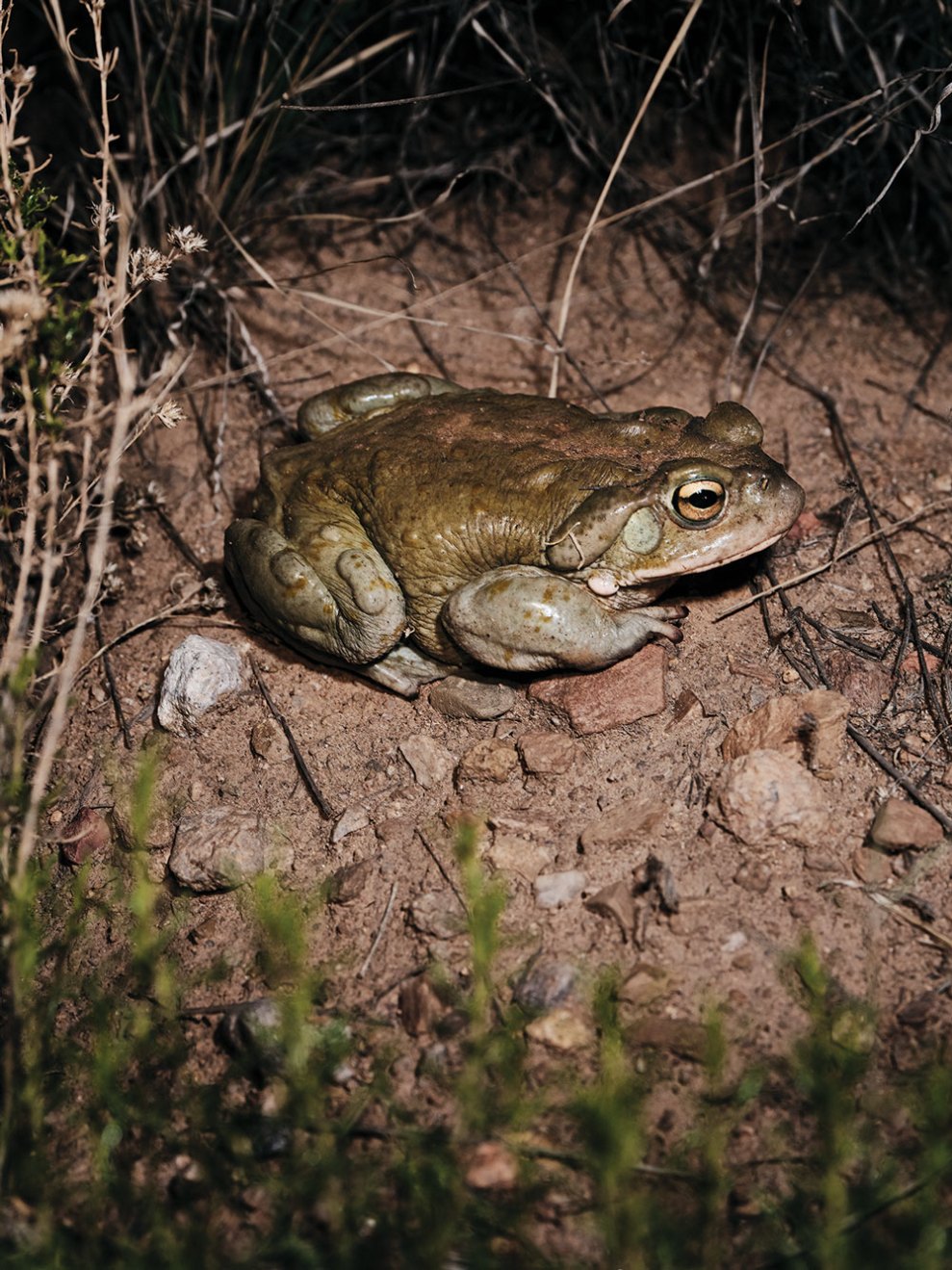
A Sonoran Desert toad.
Benjamin Rasmussen
Almost since the mining law passed, there have been calls for reform, especially of the way its broad scope seemed to invite fraud and abuse. But the fundamentals of this complex and obtuse law remain largely intact. Even when federal agencies like the Bureau of Land Management (BLM) or the Forest Service expressed deep reservations about mining plans, the law keeps them moving forward. Both the EPA and the Army Corps of Engineers disapproved of the Rosemont mine, as did Pima County leadership, concerned it would violate the Clean Water Act. After President Donald Trump nominated David Bernhardt, a former Hudbay lobbyist, to be his secretary of the Interior, the Army Corps reversed its position without explanation and issued a necessary permit under the act. This past March, the Corps decided the mine didn’t need a Clean Water Act permit at all.
But the unfettered freedom to mine may soon be coming to an end. That’s largely thanks to the persistence of Roger Flynn, an attorney whose nonprofit Western Mining Action Project has been suing mining companies—with frequent success—for more than a quarter-century. Flynn recently helped stop a massive silver and copper mine on the boundary of national forest land in Montana’s Cabinet Mountains Wilderness, and he’s now awaiting a decision on the Rosemont case from the 9th Circuit Court of Appeals. A win there would not only stop Rosemont in its tracks; it could also forever change the face of public lands mining in the West.
Flynn got involved with the Rosemont case in 2019, when he filed suit against the Forest Service and the Rosemont Copper Company in Arizona’s US District Court on behalf of the Tucson-based Save the Scenic Santa Ritas, the Center for Biological Diversity, the Grand Canyon chapter of the Sierra Club, and the Arizona Mining Reform Coalition. He made all the expected environmental claims—that the mine would violate the Clean Water Act, the Endangered Species Act, and the National Environmental Protection Act. But he aimed most of his firepower at the wording of the Mining Act itself, which states that miners have rights to permanently occupy only those public lands that contain valuable minerals.
Flynn, in other words, wasn’t contesting Hudbay Minerals’ right to mine ore from the 1,968 acres of Santa Rita mountain land that it owned outright. His case targeted the company’s plan to dump waste from its mine on another 2,447 acres of public land. Did that land contain valuable minerals that Hudbay eventually planned to extract? The company shared no data on the land’s mineral worth, and the Forest Service declined—as it usually does—to conduct a so-called validity test before approving Rosemont’s plan. Mining companies have been claiming and dumping waste on public land adjacent to their ore-filled claims for more than half a century. But just because this has become accepted practice, Flynn argues, doesn’t mean it is legal.
A native of New Jersey, Flynn graduated from the University of Colorado Law School in 1991 and within two years founded his nonprofit law firm in the tiny town of Lyons, north of Boulder. In 2002, he began teaching at his alma mater. Every year, on the first day of his Foundations of Natural Resources Law class, Flynn—who has the twinkling mien of a very tall Keebler elf—spreads a colorful territorial map of the United States across his whiteboard. Then, in a rapid and tumbling clip, he begins to lecture his students on the history of western expansion. The nation’s natural resources laws, Flynn emphasizes, cannot be understood without this background. “What was going on in 1872?” he asks. “That is what controls the decision in the Rosemont case.”
The 19th century saw more than a billion acres of land transferred from the government—which had usurped them from Native Americans—to private owners. It was a timber, mineral, range, and water free-for-all that historian Vernon Parrington cynically called the “Great Barbecue,” with only the most powerful and influential guests invited. The point was to conquer and populate this vast expanse, produce wealth, and turn citizens into taxpayers. Laissez-faire regulation left Western miners free to generate their own codes of conduct. As Louise Clappe wrote in The Shirley Letters—a series, published in the Pioneer magazine starting in 1851, that Flynn assigns to his students—gold panners on remote California rivers, fond of acting like lawmakers, “wish to have the fun of ruling themselves.”
Far from any courthouses, miners codified claim sizes, devised systems of recording their boundaries, and determined how disputes would be arbitrated—sometimes even banning lawyers from arguing cases. The disparate rules were not unified, and the miners’ trespasses were not legalized, until President Ulysses S. Grant signed the General Mining Act. Meant to reward and encourage prospecting, the law declared the mineral lands of the public domain “free and open to exploration and occupation.” And so the mining industry evolved, as historian and geographer Jared Diamond has written, “with an inflated sense of entitlement, a belief that it is above the rules.”
The law allowed prospectors on public land to stake claims of 20 acres each. After filing the necessary paperwork, they could explore and mine for as long as they wanted, provided they “worked” the claim each year. If they discovered valuable minerals, miners could extract them virtually free of charge and competition, pay no royalties on earnings, and, should they so desire, receive a title, known as a patent, to the land for either $2.50 or $5 per acre, depending on the claim’s value. (Some miners opted to skip the patent, avoiding both property taxes and the costs of environmental cleanup.) For each patented claim, miners could also stake a 5-acre “millsite” on nearby land without mineral value, using it for ancillary activities like storing equipment or piling waste.
Once a valid claim was formally patented, the landowner could do as they wished with the property; many old mining claims now host ski areas and hunting lodges. In part to discourage such abuses, in the mid-1990s the feds placed a moratorium on the granting of new patents: Miners could still explore for valuable minerals, but they had no right to permanently occupy and obstruct other uses of land that did not actually contain valuable minerals—just as the mining law mandates.
Since 1872, miners have dug, drilled, and dynamited more than $300 billion in minerals from federal public lands, leaving behind streams tinted orange by acid drainage, sulfidic waste spread over thousands of acres, and waste pits of Superfund proportions. The government estimates that cleaning up the damage to land and waterways from the nation’s half-million abandoned hardrock sites would cost the public more than $50 billion. Today, there are mining claims on some 25 million acres of public land, from which companies—some, like Hudbay, based abroad—annually cart away about $4 billion worth of hardrock minerals, including gold, silver, and copper.
Just seven years after President Grant signed the mining law, a young man named William B. McCleary struck West from Pennsylvania. Aroused as a child by romanticized tales of the region’s skirmishes between settlers and Native people, and later excited by boosters’ tales of its geological riches, McCleary “almost immediately went to prospecting,” as he told an oral historian, even though his father would have preferred that he become a priest.
When McCleary stepped off a Southern Pacific railcar in Tucson, the high slopes of the Santa Ritas beckoned. Setting up camp at the intersection of two shallow canyons, among hackberry, oak, and willow, he began demarcating roughly 30 copper claims with corner stakes or stone monuments, attaching written descriptions of the claims, with his name and the date, in tobacco tins or other containers. McCleary named the camp Rosemont after his partner, L.J. Rose, a winemaker and racehorse breeder from Los Angeles who would later become a California state senator. Other miners arrived; the camp boomed with a two-story hotel, a blacksmith shop, a store, and a school.
McCleary and Rose erected a copper smelter to process the ore they winched from the ground, but furnace trouble bedeviled them. When the contraption blew up in 1896, the partners sold their patented claims to Lewisohn Brothers, a New York metal-trading firm. (Two years later, Rose, facing bankruptcy, would take a deadly dose of morphine in his mansion; the note he left his wife concluded, “You will find my remains in the chicken yard.”)
In 1907, an industrial depression triggered the breakup of the Rosemont mining camp, but trustees of Lewisohn Brothers held onto the claims until 1961. The properties would pass through a series of corporate owners who sporadically mined but never quite hit the jackpot. By 2014, McCleary’s claims belonged to Hudbay Minerals, and geologists were predicting that bundled with scores of other claims the company had obtained nearby, the site contained nearly $20 billion worth of copper. The only thing standing in Hudbay’s way was Roger Flynn.
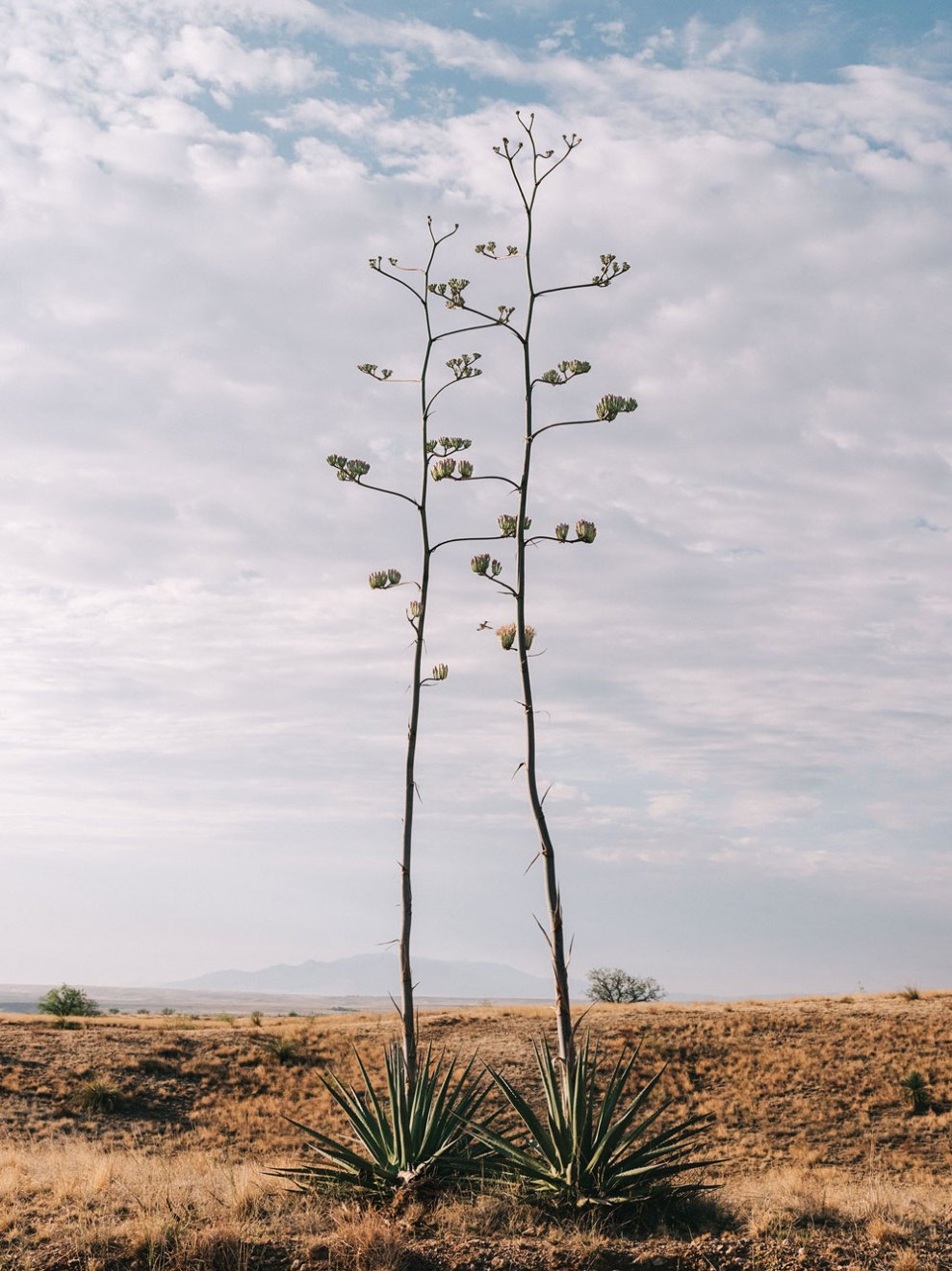
A hummingbird visits a blooming agave plant in Las Cienegas National Conservation Area.
Benjamin Rasmussen
If the mine is dug, the Forest Service predicts its ore pit will begin to fill with toxic water within three decades. The agency asked Hudbay to consider backfilling the pit with waste rock to keep water out, an option the company found “unworkable.” (According to the project’s final environmental impact statement, written by the Forest Service, backfilling would cost nearly $1 billion and take 16 years of round-the-clock work.)
After closure, the EPA anticipates the mine will also reduce flows and increase water temperatures downstream in the 43,000-acre Las Ciénegas National Conservation Area, which the agency says is home to “regionally rare, largely intact mosaics of some of the highest-quality stream and wetland ecosystems in Arizona.” That’s what concerned Julia Fonseca, Pima County’s environmental planning manager, when we started out from a trailhead in Davidson Canyon and trekked to Las Ciénegas, about 10 miles downstream from the planned mine. Butterflies, dragonflies, and birds dipped into a teacup of water near a stony outcrop—a made-to-order illustration of its value in the desert. In a slow-moving creek channel, endangered dace, topminnow, and chub darted; in cottonwood leaf litter, a rattlesnake coiled and hissed. About two-thirds of Arizona wildlife use riparian areas like this to breed, feed, or simply live.
Fonseca explained how Ciénega Creek, in this typical low-flow month, surfaced, then disappeared under sand only to reappear farther downstream. Climate change, she said, will amplify the mine’s drawdown. “This is what concerns me,” she said. “How long will it be until this creek becomes ephemeral? We’re fighting over dribs and drabs. So little water remains.”
Such landscapes are so precious to Pima County residents that in 2004 they voted to commit $173 million to acquire and protect the county’s most important natural areas. EPA models predict Rosemont’s operations and aftermath will severely reduce water flows in one of them, upper Empire Gulch, a lush, stream-fed area just miles from the mine site; one found it would be completely dewatered within 150 years. Not only does the gulch contribute to Tucson’s drinking water supply, it provides habitat for rare plants and animals while attracting visits and spending by birdwatchers, campers, hikers, bikers, horse riders, and photographers. Without sufficient moisture, large trees in the gulch are predicted to die, prompting a transition to dry desert wash.
It’s difficult to know exactly how dry the area will become, and when. Consultants hired by Pima County estimate the Ciénega watershed will be dry within 50 years. Rosemont predicts it will take 1,000. Both sides have their own motivations, acknowledges Randy Serraglio of the Center for Biological Diversity, but “the company is solely interested in getting at billions of dollars’ worth of copper, while the county is charged with protecting the environment and the well-being of the people who live here.”
No one is arguing that the world doesn’t need copper—to build homes, electronics, electric-vehicle batteries, solar heaters, wind turbines, and so on. Arizona is already home to two open-pit copper mines operating in degraded landscapes, and neither is running out of ore anytime soon. Utah and New Mexico also produce large quantities of copper; Chile and Peru produce much, much more. But Arizona has long been especially friendly to mining interests: Copper clads its Capitol dome, and a copper-colored star marks the center of its state flag. Both Gov. Doug Ducey and his predecessor, Jan Brewer, promoted the Rosemont mine for its economic benefits.
According to Hudbay, its mine—projected to make up 10 percent of US copper production—will generate $357 million in local taxes over its 20-year lifespan and employ 500 people at good wages. But that would make the Rosemont mine only the state’s 110th largest employer, according to a letter Pima County administrator Chuck Huckelberry sent to the county’s board of supervisors, pointing out that “the adverse environmental impacts of Rosemont are quite likely more than most of the other higher-ranked employers combined.” A county-backed study found that if the mine deterred a mere 1 percent of nature-based tourism spending—in the greater Tucson area, estimated at $683 million a year—the economic loss would be greater than the project’s entire annual payroll.
Federal law compels miners to conduct their operations “where feasible,” in a manner that “minimize[s] adverse environmental impacts in National Forest surface resources.” And so instead of an impoundment pond, the company says it will heap its tailings and its waste rock using a “dry stack” method, piling and compacting them with native soil and vegetation. Hudbay says that will reduce the project’s footprint, its water consumption, and the risk of toxins seeping into groundwater, but no dry-stack system currently operational is capable of processing Rosemont’s projected daily waste.
To help mitigate its impact on the Ciénega Creek watershed, Rosemont has purchased rights to 1,122 acre-feet of water a year (1 acre-foot can support a family of four for a year) from a golf course some 20 miles north of the mine. It plans to route this water into the lower watershed, well below the conservation area. The Forest Service didn’t analyze whether these mitigations would actually offset the area’s water losses, claiming—erroneously, says Flynn—that it lacked jurisdiction. To further demonstrate its environmental bona fides, the company committed to spending $6.25 million to monitor and survey conservation property, remove nonnative species, plant trees, slow stream flow, and exclude livestock from the Ciénega Creek basin.
Those steps are not nearly enough to satisfy mine opponents, who say they won’t offset the project’s most extreme harms: the creation of the pit lake, which could attract wildlife to its toxic shore, and the loss of water in Empire Gulch, the wetland most vulnerable to mine operations. Wherever Rosemont’s mitigations take place, Serraglio says, they will be “a band-aid on an amputation wound. Even if applied, Empire Gulch and Ciénega Creek will very likely bleed to death anyway.”
On July 23, 2019, Judge James A. Soto called his crowded Tucson courtroom to order. For three hours, defendants and plaintiffs—who, beside Flynn’s clients, included three local tribes who argued the mine would irreparably damage their cultural resources—presented 20-minute distillations, and then rebuttals, of thousands of pages of briefs.
Andrew Smith, a 24-year veteran Department of Justice attorney representing the Forest Service, began by defending Rosemont’s right to dump waste on the 2,447 acres of public land near its proposed ore pit. He noted that agency regulations from 1974 say the piling of waste is “an integral part of a pit mining operation” and is therefore authorized “regardless of whether [those piles] are on or off mining claims.” The agency, he added, cannot “materially interfere with reasonably necessary activities under the General Mining Law that are otherwise lawful.”
Flynn countered that Rosemont’s argument that it was entitled to dump tailings on this swath of national forest was “based on quicksand” because absent proof of valuable minerals, it has no statutory right to permanently occupy that land. As Flynn often tells his law students, statutes, enacted by Congress, trump regulations, created by agencies. If the activity on those acres was not authorized by the Mining Act, then it wasn’t authorized by the regulation either. The Forest Service ought to have denied the mine.
It was a clever argument. “If you are going to use this outdated law, then the letter of that outdated law says there has to be a study” of the land’s mineral value, says Democrat Raúl Grijalva, who represents parts of Tucson in Congress and chairs of the House Natural Resources Committee. “And that’s been conveniently cut out of that process.”
“Roger’s arguments are not only persuasive and consistent with what many of us who have tracked the mining law and its history believe is the law,” says University of Wyoming College of Law professor Sam Kalen, “but the outcome could ensure that companies are allowed to use open public lands…only when the lands qualify as containing a valuable mineral deposit.”
You might be wondering: Hasn’t this fundamental question—about the placement of waste piles on land that may or may not contain valuable minerals—come up before? After all, miners have been building escarpments of waste on public land since the dawn of the modern mining era. But the Forest Service and the BLM have always looked the other way, Flynn says, bolstered by long-standing tensions between the statutory text of the Mining Act and latter-day agency requirements to allow mineral extraction.
Things were almost cleared up at the end of 2000, when Interior Secretary Bruce Babbitt, a longtime proponent of mining reform, issued an order saying miners did not have the right to occupy, for ancillary purposes, more than 5 acres of “nonmineral” land per unpatented claim. Environmentalists rejoiced. But no new regulations were enacted. Bill Clinton was on his way out, George W. Bush was coming in, and Babbitt’s order was reversed. Twenty years on, just as he was leaving the White House, Donald Trump ordered the Interior Department to codify, once and for all, the right to store tailings on federal land—a move that Joe Biden will likely reverse. As this seesaw history suggests, in the absence of legislative reform, confusion will continue to reign.
“There’s a long history of administrative agencies and courts looking at the mining law and going, ‘Aww, let them go ahead and do what they want. This is too complicated, and we don’t want to rock the boat,’” says John D. Leshy, an emeritus professor of environmental law at the University of California, Hastings College of Law, who served as solicitor general in Clinton’s Interior Department and as an informal, unpaid consultant to attorneys fighting Hudbay. “If [Rosemont is] using these public lands illegally, under a law that doesn’t support it, then a court could say Roger is right…And that would upend the mining law.”
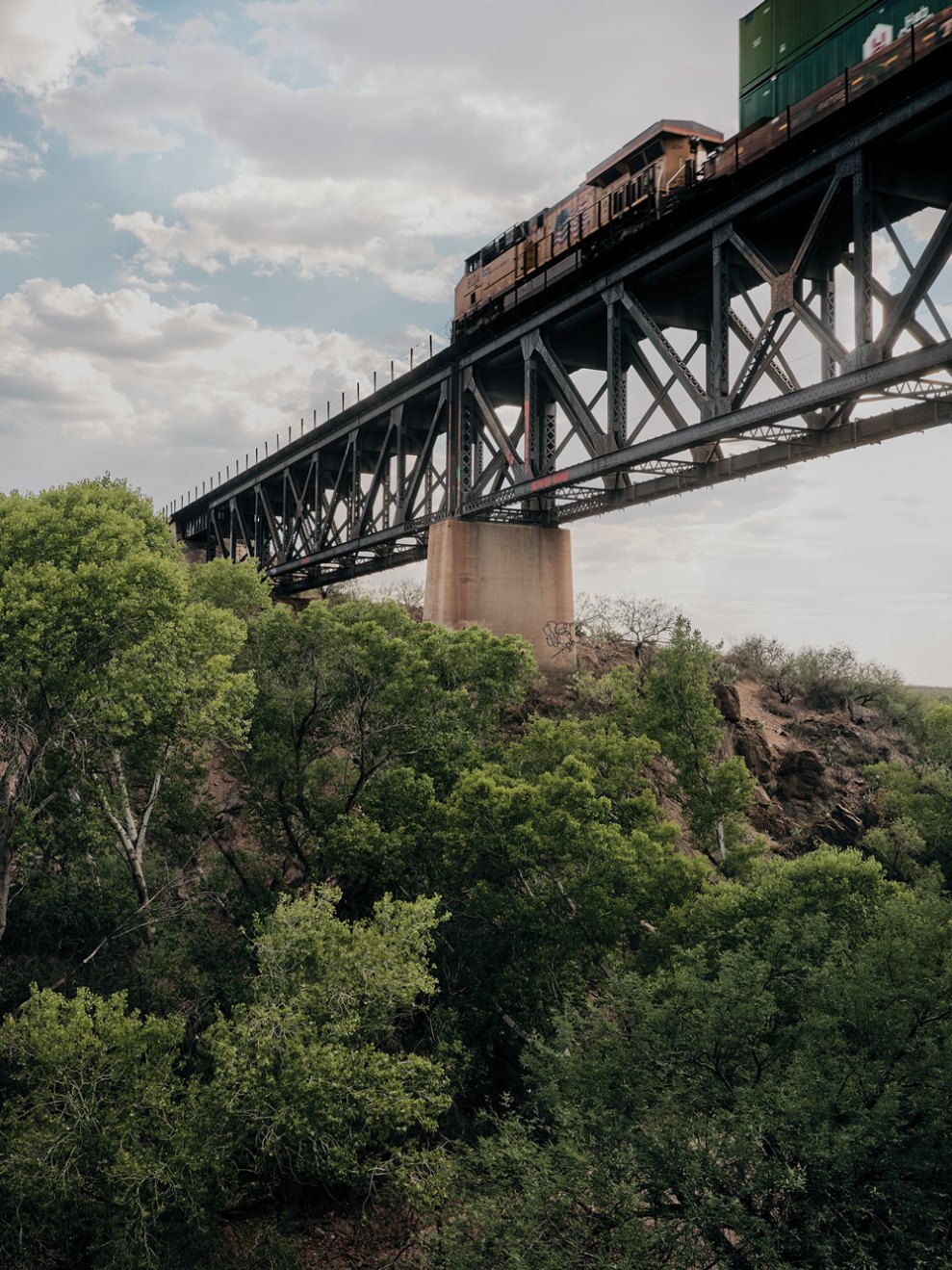
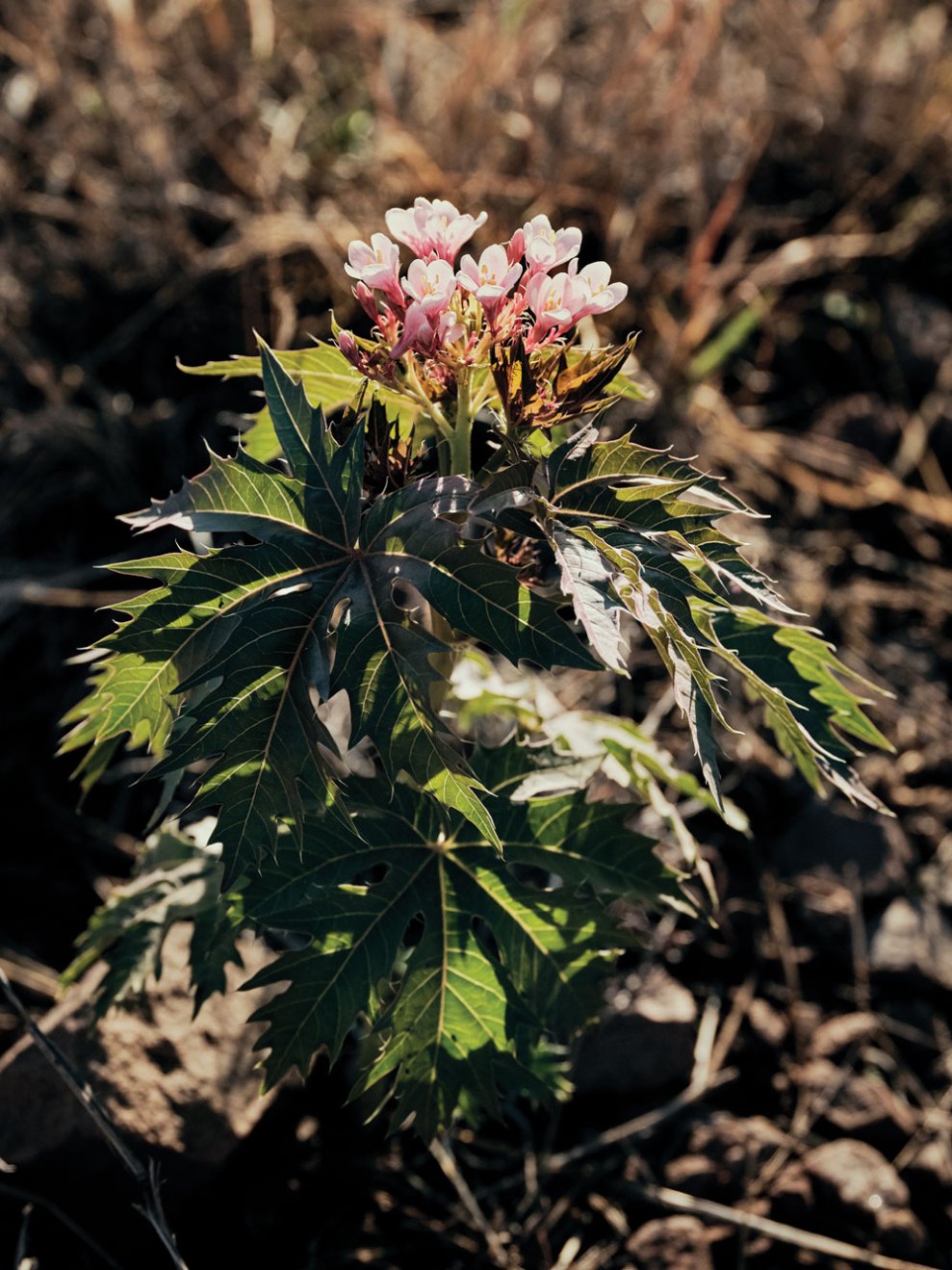
A week after the court hearing, Judge Soto in effect said Roger was right. In a lengthy ruling in the plaintiffs’ favor, Soto wrote that by accepting without question that Rosemont’s unpatented claims were valid—that is, that they contained valuable minerals—the Forest Service had committed “a crucial error” that “tainted [its] evaluation of the Rosemont Mine.” By assuming it could not materially interfere with Rosemont’s mining plan, the Forest Service had failed to take the requisite “hard look” at the mine’s impacts, making the mine’s approval arbitrary and capricious.
Rosemont’s proposal to bury its 2,447 acres of unpatented mining claims under 1.2 billion tons of waste “was a powerful indication that there was not a valuable mineral deposit underneath that land,” Soto wrote. As for the acts and regulations cited by Rosemont and the Forest Service, they did not “create freestanding mining rights” beyond the parameters of the mining law.
Later, on the phone from his office in Lyons, Flynn said that when the federal government was giving away land for grazing, logging, railroads, and white settlement, “the mining industry always thought their pieces of the pie were unlimited.” He paused, and I imagined his Keebler grin. “Bottom line: not nearly as much as they believed.”
The day after the ruling, which industry observers dubbed “unprecedented,” Hudbay shares fell more than 20 percent. The company announced an appeal, stating, “We strongly believe that the project conforms to federal laws and regulations that have been in place for decades.” In a blog on the website of the Snell & Wilmer law firm, which has long represented mining interests, attorneys James Allen and Michael Ford predicted the decision would be received with “shock and dismay” throughout the industry. It was, they wrote, “likely the most significant federal court decision on federal mining law in several decades and touches on issues that have simmered since the Clinton Administration.” Salt Lake City–based mining attorney Daniel Jensen told the Arizona Daily Star that if decisions like Soto’s became the norm, they would lead to chaos and further delays in public lands mining reviews.
As the coronavirus raged, lawyers prepared for their 9th Circuit hearing; the National Mining Association and the US Chamber of Commerce filed an amicus brief on behalf of defendants; and 84 of the nation’s leading law professors filed on behalf of plaintiffs. The stakes, as everyone knew, were extremely high. “The District Court’s misreading of the applicable law,” Rosemont’s attorneys wrote in their opening brief, “will render impossible or infeasible mining operations of any consequence on national-forest lands open to mineral entry.”
It sounded apocalyptic. But as Flynn argued by Zoom before the appellate panel in early February, mining would not necessarily be impossible. Hudbay could redo its mining plan and find another place to dump its waste, he said. It could seek a land exchange with the Forest Service—swapping private land for public, as Rio Tinto is doing to mine copper from the Tonto National Forest, also in Arizona. Hudbay could buy private land for its tailings, place them atop their own patented claims, or request a special use permit from the Coronado National Forest. The agency, exercising its discretionary powers, could then charge Rosemont full market value for use of that land. (How much might that be? No one knows; it’s never come up.)
There are still other options. The Forest Service could require Rosemont to do a complete environmental restoration. Or it could simply tell the company to get lost. In other words, as Leshy said, “You take the mining law out of the picture, and the playing field between the government and the company is rather level.”
Changing the mining law would, of course, involve Congress, which has long resisted substantive reforms. One pushed by environmentalists would scrap the anachronistic claiming system in favor of a leasing scheme, akin to the one used by the oil and gas industry, which pays 12.5 percent royalties to the federal government on gross income earned from public lands and waters. In 1995, House Republicans, influenced by industry, proposed a 5 percent royalty for mining that would have allowed companies to deduct all expenses before calculating their payments. This “sham reform,” says Lauren Pagel, policy director for Earthworks, which campaigns against destructive mineral extraction, would often result in zero payments. That bill, like others before it, went nowhere.
In a letter written in April 2021, 16 House Democrats joined Rep. Grijalva in urging Interior Secretary Deb Haaland and Agriculture Secretary Tom Vilsack to end this “obsolete system put in place by the Mining Law of 1872.” The lawmakers asked the secretaries to clarify that federal land managers can deny permits for projects that would cause outsize harm to public resources and block waste piles on land that doesn’t contain a valuable mineral deposit. “We are returning the option of saying no,” Grijalva said. “There are some places in this country, on public lands and waters, that should not be disturbed by mining.” Grijalva intends to introduce a bill later this year that would abolish the 150-year-old claims process, establish royalties on hardrock extraction, and earmark the proceeds for cleaning up abandoned mines. It stands a good chance in the House; the Senate is less certain.
Even though the mining industry might benefit from a modernized law, one that clarifies its standing and keeps disputes out of court, miners do not want to throw out their baby—their perceived right to mine on public lands with few restrictions—with the bathwater. After all, they have had a pretty good run. When asked to comment on Grijalva’s reform efforts, a Hudbay spokesperson said, “We are committed to abiding by the existing regulations and laws.” The National Mining Association also said it feels sufficiently regulated (no surprise) but added that it has “always been open to discussions around the General Mining Law, but proposals we have seen in the past have been so punitive that they have been non-starters.”
Hudbay has expressed confidence that it will prevail in the 9th Circuit, whose decision could arrive anytime. Flynn refuses to speculate on the outcome, though he notes a ruling in his clients’ favor would affect all new large mines on federal land in the West—not just mines already approved but also those under judicial review. Such a decision would almost certainly force industry to hurry back to Congress and finally start reconsidering the legislative compromises it could stomach.
John D. Leshy, among others, relishes the prospect of debate on the future of hardrock mining. “The facts, if you laid them out for the average person, they’d say, ‘Gosh, why isn’t someone doing something about this?’ The case is so good, as a matter of public policy, that sooner or later people are going to wake up.”
This article has been updated with a correction.

